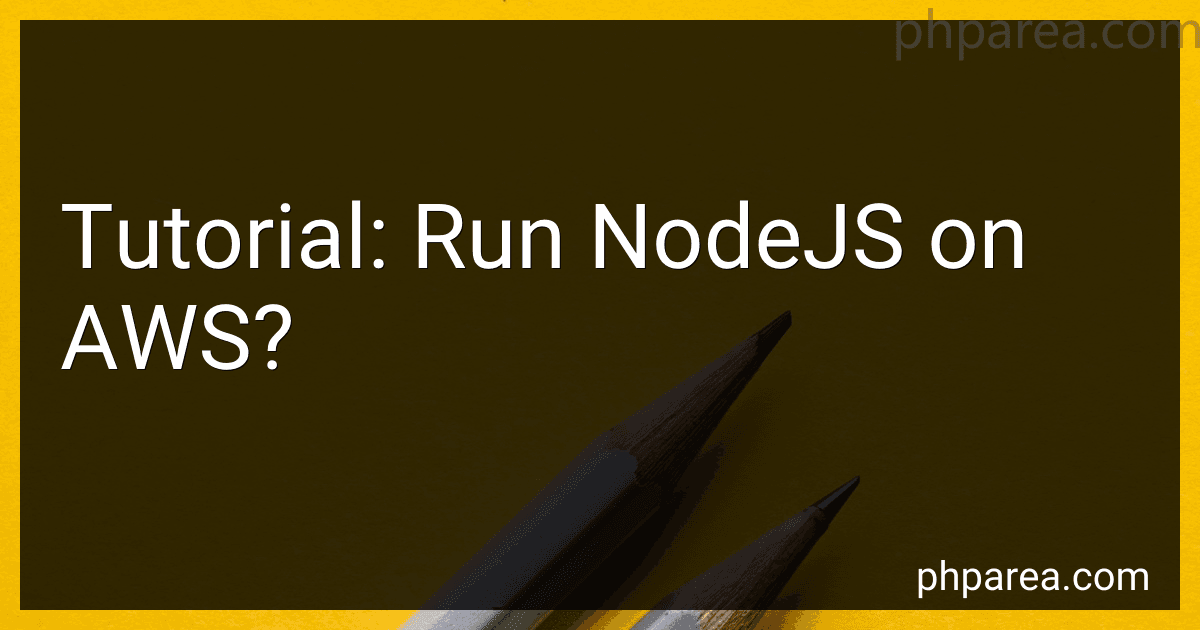Best AWS Hosting Solutions to Buy in December 2025
Running Node.js on AWS (Amazon Web Services) is a straightforward process that involves a few steps. Below is a brief overview of how to achieve this:
- Set up an AWS EC2 Instance: Log in to your AWS Management Console and navigate to the EC2 Dashboard. Launch an EC2 instance by selecting a suitable AMI (Amazon Machine Image) with Node.js support. Configure the instance settings, such as instance type, security groups, and storage. Create or choose an existing key pair to securely connect to the instance. Launch the instance and wait for it to start running.
- Connect to the EC2 Instance: Connect to the EC2 instance using either SSH or the AWS Management Console's browser-based SSH client.
- Install Node.js on the EC2 Instance: Update the package manager by running the appropriate command for your Linux distribution (e.g., sudo apt update for Ubuntu). Install Node.js and npm (Node Package Manager) using the package manager (e.g., sudo apt install nodejs). Verify the successful installation by checking the Node.js and npm versions.
- Develop and Upload Node.js Application: Write your Node.js application code using a text editor or an integrated development environment (IDE). Save the application code with a .js extension and any required dependencies in a specific directory. Upload the Node.js application files to the EC2 instance using secure file transfer methods such as SCP (Secure Copy), SFTP (SSH File Transfer Protocol), or Git.
- Install Application Dependencies: Navigate to the application directory on the EC2 instance using the command line. Install the required Node.js packages by running npm install.
- Run the Node.js Application: Execute the Node.js application by running the node command followed by the name of the application file (e.g., node app.js). Optionally, you can use process managers like PM2 to keep the application running in the background and ensure automatic restart on failure.
That's it! You have now successfully set up and running a Node.js application on AWS EC2. Remember to properly manage security groups, configure DNS settings, and monitor the instance for optimal performance and scalability.
What is Node.js?
Node.js is a JavaScript runtime environment that allows developers to run JavaScript code outside of a web browser. It is built on the V8 JavaScript engine, which is also used by the Chrome browser, and provides an event-driven, non-blocking I/O model that makes it lightweight and efficient for building scalable network applications. Node.js is often used to build server-side applications and has a vast ecosystem of open-source libraries and modules available for developers to leverage.
What is Amazon RDS?
Amazon RDS (Relational Database Service) is a web service offered by Amazon Web Services (AWS) that makes it easier to set up, operate, and scale a relational database in the cloud. It provides managed database services for various relational databases, including Amazon Aurora, MySQL, PostgreSQL, Oracle, and Microsoft SQL Server.
Amazon RDS handles common administrative tasks such as hardware provisioning, database setup, patching, automated backups, and other ongoing maintenance tasks. It also allows users to easily scale their database resources up or down depending on the application needs, without the need for manual intervention.
Amazon RDS offers features like automated backups, continuous monitoring, automatic software patching, and enhanced security features. It provides high availability and durability for databases by replicating data across multiple Availability Zones. This ensures that the database remains highly available and resilient to any infrastructure failures.
Additionally, Amazon RDS integrates with other AWS services, such as Amazon CloudWatch for monitoring, AWS Identity and Access Management (IAM) for managing access control, and Amazon VPC for network isolation and security.
Overall, Amazon RDS simplifies the management and operation of relational databases, allowing users to focus on their applications rather than the underlying infrastructure.
How to configure a Route 53 DNS record for a Node.js app on AWS?
To configure a Route 53 DNS record for a Node.js app on AWS, you can follow these steps:
- Sign in to the AWS Management Console and open the Route 53 console.
- Go to the hosted zones section and select the desired hosted zone for your domain.
- Click on the "Create Record Set" button to create a new DNS record.
- In the "Name" field, enter the subdomain or domain name you want to use for your app (e.g., "app.example.com").
- Set the "Type" to "A - IPv4 address" if you want to point to an IP address or "CNAME - Canonical name" if you want to use a domain name.
- In the "Value" field, enter the IP address of your server or the domain name where your app is hosted.
- Optionally, you can set the "Alias" field to "Yes" if you want to use an Alias record, which allows you to map your DNS record directly to AWS resources like an Elastic Load Balancer, CloudFront distribution, or an S3 bucket.
- Repeat these steps if you need to configure additional DNS records for your app, such as MX records for email or TXT records for verification purposes.
- Click on the "Create" button to save the DNS record.
Once you configure the DNS record, it may take some time for the changes to propagate. You can use the AWS Route 53 console to check the status of your DNS record.
How to create an EC2 instance on AWS?
To create an EC2 (Elastic Compute Cloud) instance on AWS (Amazon Web Services), follow these steps:
- Sign in to the AWS Management Console.
- Open the Amazon EC2 console at https://console.aws.amazon.com/ec2/.
- In the EC2 Dashboard, click on the "Launch Instance" button.
- Select an Amazon Machine Image (AMI): Choose an AMI based on your requirements, such as the operating system and software pre-installed.
- Choose an Instance Type: Select the desired instance type based on your compute, memory, storage, and networking needs.
- Configure the Instance: Set up additional configurations like the number of instances, network settings, security groups, storage options, etc.
- Add Storage: Define the storage options for your instance, such as the size and type of the root volume.
- Add Tags (optional): Assign tags to your instance for better organization and management.
- Configure Security Group: Define the inbound and outbound rules for the instance's security group to control the traffic flow.
- Review and Launch: Review all your configurations and settings to ensure they are correct. Also, choose an existing key pair or create a new one to securely access your instance.
- Click on the "Launch" button to initiate the creation of the EC2 instance.
- A dialog box will prompt you to choose whether to create a new key pair or select an existing one. If creating a new key pair, provide a name and download the private key file (.pem). Make sure to keep this file securely.
- Once the instance is launched, you will see a confirmation message. Click on the "View Instances" button to access the EC2 Console and monitor the instance's status.
That's it! You have successfully created an EC2 instance on AWS.



